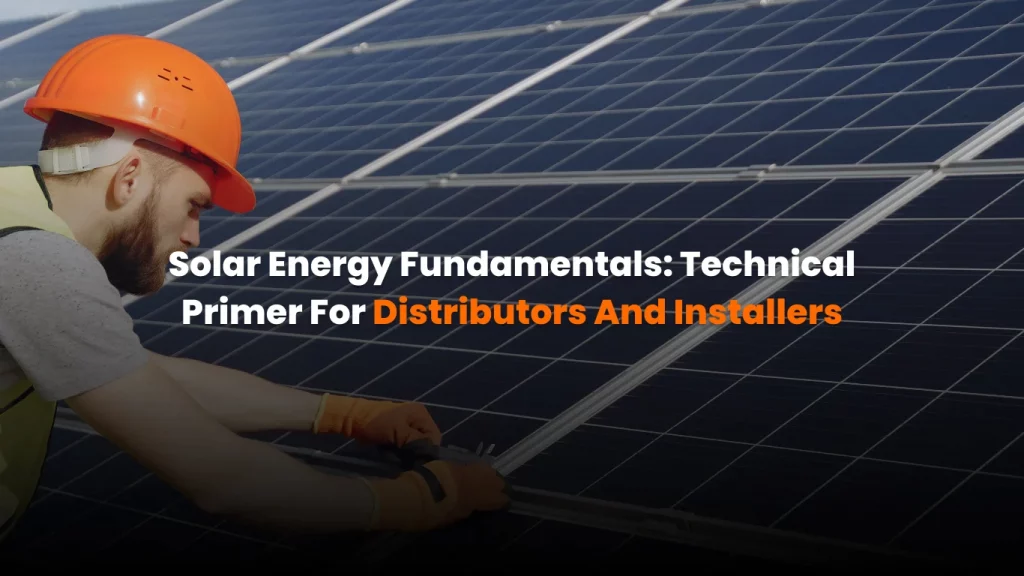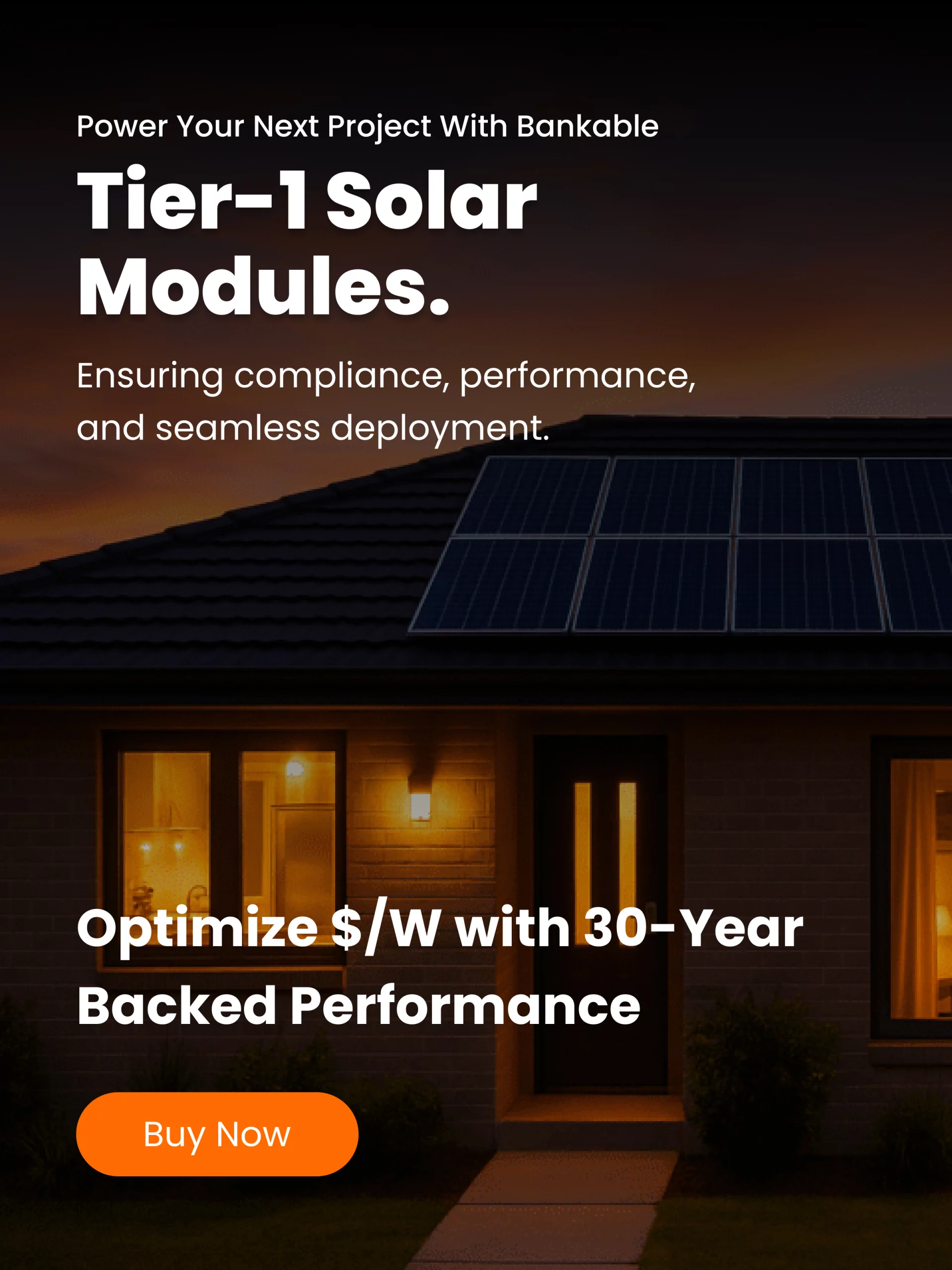Energy is now one of the most dynamic parts of the U.S. electricity mix. In 2024 the United States installed 50 GW of new solar capacity, a 21 percent year-over-year increase, and projections suggest cumulative capacity could reach 739 GW by 2035. Understanding solar energy fundamentals helps distributors and installers interpret this rapid growth. This primer explains how photovoltaic (PV) cells generate power, the system components that convert sunlight into usable alternating current (AC) electricity, the differences among panel types, inverters and batteries, and why mastery of these basics helps B2B buyers evaluate products and manage long-term performance.
How Photovoltaic Technology Works
Photovoltaic materials convert sunlight into electrical energy. A PV cell is the smallest building block of a solar module and produces about one or two watts of direct current (DC) electricity. The cells are thin wafers made from semiconductor materials such as silicon and are sandwiched between protective glass and plastics. To increase power output, cells are linked in series to form modules or panels. Panels can be used individually or combined into arrays; one or more arrays connect to the grid through a complete PV system.
Solar Cell Construction and the Photovoltaic Effect
PV cells work because sunlight excites electrons in semiconductors. Silicon wafers are doped to create N-type and P-type layers. When light hits the cell, photons dislodge electrons from atoms; an electric field at the N–P junction pushes these electrons in one direction, creating a DC current. Each cell contains metal contacts and thin grid lines on the surface that collect electrons and send them to busbars. Electrons then return to the opposite side, forming a continuous circuit.
Modules and Arrays
The modular nature of PV technology allows systems to be scaled up. Typical commercial panels contain 60 to 72 cells. Multiple panels form arrays that meet residential, commercial or utility-scale requirements. Arrays mount on racking systems that tilt them toward the sun, and wires link them to inverters and other balance-of-system components. The modular structure means PV systems can be designed for small off-grid loads or multi-megawatt solar farms. Large utility plants in the United States, such as the Solar Star and Topaz farms in California, produce 550–579 MW of electricity, demonstrating how scalable the technology is.
Core Components of a PV System
A complete solar energy system consists of several hardware categories. The table below summarises the core components and their functions:
| Component | Primary Function | Notes |
|---|---|---|
| Solar panels (modules) | Capture sunlight and convert it into DC electricity | Panels contain PV cells. Commercial modules typically have 60–72 cells. |
| Inverters | Convert DC electricity into usable AC power | Types include string inverters, microinverters and power optimizers. They also synchronise the output with the grid. |
| Racking and mounting | Secure panels on roofs, ground mounts or tracking systems | Proper orientation maximises energy harvest. |
| Batteries | Store excess energy for off-grid or hybrid systems | Battery chemistry affects capacity, efficiency and lifespan. |
| Charge controllers | Regulate power flow between panels, batteries and loads | Essential for off-grid or hybrid setups. |
| Disconnect switch & meter | Allow safe shutdown and track energy flow to and from the grid | Required for code compliance. |
Inverters: Turning DC into AC
Solar panels generate direct current, but most electrical devices and the grid operate on alternating current. Inverters perform this critical conversion. They use transistors and switching elements to turn DC into AC and filters to smooth the output. The inverter matches the frequency and phase of grid power so that solar electricity can integrate seamlessly with utility service.
There are three primary inverter architectures:
- String inverters gather power from a series of panels and route it into one central unit. They are cost-effective and suitable where panels receive uniform sunlight, but shading on one module can reduce output across the string.
- Microinverters sit on each panel or pair of panels. They convert DC to AC at the module level, mitigating shading losses and enabling panel-level monitoring.
- Power optimizers are similar to microinverters but feed into a central string inverter. They optimize individual panel performance and improve system efficiency.
Inverters also include control electronics, such as microcontrollers and digital signal processors, to manage switching and regulate voltage and frequency. Filters and transformers refine the waveform and step voltages up or down. Understanding inverter topology helps distributors advise customers on performance trade-offs and installation complexity.
Battery Storage Fundamentals
Energy storage allows solar systems to provide power when the sun is not shining and improves resilience. Two common chemistries are lithium-ion and lead acid. They differ significantly in performance and cost:
- Cost and efficiency: Lead acid batteries are less expensive up front, while lithium-ion batteries cost more but are more efficient and deliver higher performance. Lithium-ion technology generally offers greater reliability, efficiency and lifespan.
- Capacity and depth of discharge: Lithium-ion batteries typically store 15 kWh or more and allow 85 percent depth of discharge, whereas lead acid systems often store 1.5–5 kWh and should not be discharged beyond 50 percent.
- Efficiency: Lithium-ion batteries are 95 percent efficient or higher, while lead acid batteries achieve 80–85 percent efficiency.
- Lifespan: Lithium-ion products generally last 10–15 years with many more charge cycles compared with lead acid batteries, which last 3–12 years.
Lithium-ion technology is therefore usually the better choice for commercial solar and backup applications, despite higher upfront costs. Lead acid batteries may still be appropriate for off-grid systems that are seldom used. Distributors should highlight these differences when advising installers on storage options.
Types of Solar Panels and Their Characteristics
Solar panels are commonly classified by the type of silicon cell:
- Monocrystalline: These panels are cut from a single crystal of silicon. They have a uniform appearance and higher efficiency, typically around 20 percent or more. Monocrystalline modules perform better in high-temperature conditions and occupy less area per watt, making them attractive for space-constrained commercial installations.
- Polycrystalline: Polycrystalline cells are made by melting many silicon fragments together. They are less expensive to manufacture but have slightly lower efficiencies (about 15–18 percent). Polycrystalline modules still provide reliable power output, so they remain popular in price-sensitive projects.
While efficiency differences exist, both mono and poly modules produce DC electricity via the same photovoltaic effect. Distributors should review data sheets for cell count, wattage and temperature coefficients when evaluating modules for specific installations.
Market Trends: Why Fundamentals Matter for B2B Buyers
The rapid growth of the U.S. solar industry underscores the importance of understanding fundamentals. The U.S. installed 50 GW of new solar capacity in 2024. Breaking down this record-setting year reveals distinct patterns by market segment:
- Utility-scale: With 41.4 GW added in 2024, the utility segment dominated growth, posting a 33 percent year-over-year increase. Developers installed over 16 GW in the fourth quarter alone.
- Residential: The residential market installed 4,710 MW, a 32 percent decline due primarily to policy shifts and high interest rates. Forecasts still project 9 percent growth in 2025 and more than tripling of capacity by 2035.
- Commercial: Commercial solar installations reached 2,118 MW, an 8 percent increase compared with 2023. Growth was driven by projects in California, Illinois, New York and Maine.
- Community: Community solar programs added 1,745 MW, growing 35 percent year over year. These programs allow multiple subscribers to benefit from a shared local solar system.
Domestic manufacturing is also expanding. U.S. module factories increased capacity from 14.5 GW in 2023 to 42.1 GW in 2024 — a 190 percent growth. Texas alone installed 11.6 GW of new capacity in 2024, maintaining its top rank among states.
Visualizing Market Segments
Alt text: Solar capacity additions by segment in 2024 show that the utility-scale segment added 41,400 MW, residential added 4,710 MW, commercial added 2,118 MW and community solar added 1,745 MW. Utility projects dominate.
Why Understanding Fundamentals Helps B2B Buyers
For distributors and installers, technical knowledge translates into better project outcomes:
- Product evaluation: Knowing how PV cells generate electricity and how panels differ allows buyers to assess efficiency ratings, temperature coefficients and warranties. Understanding that PV modules are modular systems built from 60–72 cells helps evaluate output relative to size and cost.
- System design: Insight into inverter architectures and battery chemistries aids in selecting the right configuration. Recognising when microinverters or power optimizers are preferable — for example in shaded commercial roofs — can maximize energy production. Understanding battery depth of discharge and efficiency helps choose storage systems that meet resilience requirements.
- Regulatory compliance: Familiarity with disconnect switches, bi-directional meters and mounting systems ensures systems meet building codes and interconnection standards.
- Risk management: Recognising market trends such as the rapid expansion of utility-scale projects and manufacturing capacity helps anticipate demand and manage inventories. Awareness of policy-driven swings in the residential market prevents over-ordering and aligns marketing with growth segments.
Conclusion
The ongoing expansion of the U.S. solar market presents enormous opportunities for distributors and installers, but success depends on mastering solar energy fundamentals. PV cells convert sunlight into DC power, which is then transformed into AC electricity through inverters. Complete systems incorporate panels, inverters, racking, batteries, charge controllers, disconnects and metering. Evaluating module types, inverter architectures and battery chemistries allows B2B buyers to recommend optimal solutions for each project. Market growth data show that commercial and community segments are expanding, while utility-scale projects dominate overall capacity additions. By grounding purchasing decisions in fundamental knowledge, solar professionals can deliver reliable installations, adapt to market shifts and ensure long-term value for their clients.




